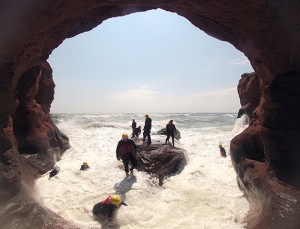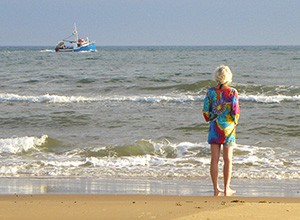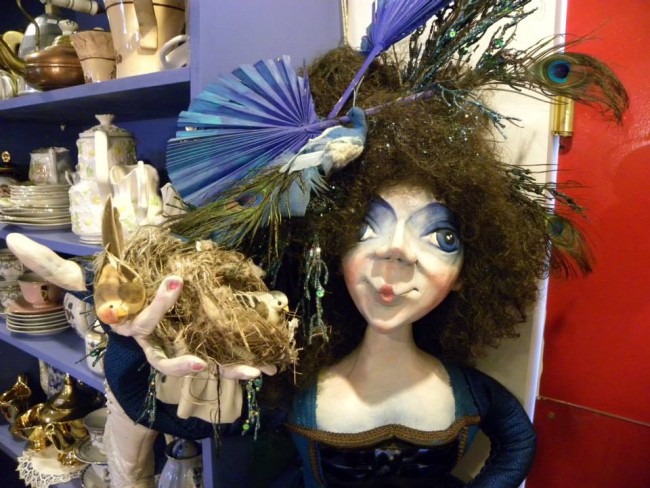 I hurled myself off the sandstone cliff edge of The Bluff, arms crossed in front of my chest, slicing sideways into the foaming surf. The surging wave thrust my body onto the smooth, bright red cliff face and I blasted into the cave’s interior, insulated from the stony surface by my wet suit and a thin layer of water that rendered my movement almost frictionless. I aquaplaned along the twisting, sinuous surface of the slick rock face for what seemed a suspended moment of eternity, then, the wave expended and I found myself deposited safely onto a ledge. I had just taken a venture into the “Roman Bath,” off Quebec’s maritime Magdalen Islands at what might just be the world’s newest extreme sport-an experience I’m dubbing “cave surfing.”
I hurled myself off the sandstone cliff edge of The Bluff, arms crossed in front of my chest, slicing sideways into the foaming surf. The surging wave thrust my body onto the smooth, bright red cliff face and I blasted into the cave’s interior, insulated from the stony surface by my wet suit and a thin layer of water that rendered my movement almost frictionless. I aquaplaned along the twisting, sinuous surface of the slick rock face for what seemed a suspended moment of eternity, then, the wave expended and I found myself deposited safely onto a ledge. I had just taken a venture into the “Roman Bath,” off Quebec’s maritime Magdalen Islands at what might just be the world’s newest extreme sport-an experience I’m dubbing “cave surfing.”
Composed of eight islands, seven inhabited and six of them interconnected by dune complexes, the Magdalens boast white sand beaches and picturesque red sandstone cliffs. They exist as an exotic destination for those who don’t want to venture too far from home and, in fact, the archipelago can be seen from Cape Breton, N.S. and eastern Prince Edward Island. Until recently, the islands remained almost the unique preserve of the Francophone cognoscenti of Quebec, yet despite the past perceptions of exclusivity, they are actually remarkably accessible. From Souris, P.E.I., it’s a five-hour ferry ride, with a round trip for a car and two people costing a reasonable $400 including tax. Air service is also available to the Magdalens from Montreal, Quebec City and Gaspé, Que. Just over 200 square kilometers in area, the islands are easily traversed by automobile on what must be one of Quebec’s shortest highways, the 199.
Far more than a haven for cave surfing, the Magdalens are dotted with fascinating shops, art galleries and quaint inns. Kite boarding and wind surfing are popular activities here and there are programs and camps for children, making this a good family destination. The archipelago also boasts gastronomic draws like À l’abri de la Tempête microbrewery and pub, Le Fumoir d’Antan smokehouse (which offers a delicious history lesson on smoking herring), and the Fromagerie du Pied-de-Vent for homemade cheese.
The bucolic island of Havre Aubert affords the opportunity to unwind and enjoy the beach and sea air, while the unusual, funky L’Étang-du-Nord features everything from a kite boutique to the charming Le Flâneur gallery, with its life-sized papier-mâché replicas of the islands’ inhabitants. If stained glass is your passion, look no further than the Verrerie la Meduse (“jellyfish glass works”) located in a century old school house on Havre aux Maisons.
The best place for adventurous types is the rustic, but comfortable La Salicorne Inn on Île de la Grande Entrée. Aptly named for a halophilic (salt-loving) plant, the hotel is situated in the middle of a thin stretch of land and offers magnificent views of both sides of the sea. The resort is a co-operative effort of the community-local villagers are the owners of La Salicorne-and they take great pride in the lodging, even naming the rooms for local residents. Guests at the hotel can sign up for packages that include sea and surf kayaking and, of course, cave surfing.
A major draw of La Salicorne is that the shallow basin adjacent to the hotel is sheltered from the open ocean by a narrow band of huge dunes, making for warmer and more serene waters, ideal for family canoeing, hiking, kayaking and swimming. Nearby, however, surf blasts and pounds a coastline marked by kilometres of magnificent sandy beaches and imposing red-hued rock faces. The neighbouring Anglophone community of Grosse Île (home to descendants of Scottish settlers) provides a nice cultural counterpoint to the Francophone Île de la Grande Entrée.
 The Magdalens are known for superb seafood, and scenic fishing wharves dot the archipelago. An early July lobster festival on Île de la Grande Entrée marks the end of the lobster season and features music and dancing. If crustacean is not to your taste, there are many events throughout the year including a Sandcastle Building Competition, Model Ship Building Contest, Story Telling Festival, Biking Festival and an Acadian Weekend.
The Magdalens are known for superb seafood, and scenic fishing wharves dot the archipelago. An early July lobster festival on Île de la Grande Entrée marks the end of the lobster season and features music and dancing. If crustacean is not to your taste, there are many events throughout the year including a Sandcastle Building Competition, Model Ship Building Contest, Story Telling Festival, Biking Festival and an Acadian Weekend.
Visitors should plan on spending four to seven days on the Magdalen Islands. Expect to be seduced by the open smiles of the island’s people, by the art, the locally produced food and beverages, the music, the theatre and the ambiance of what is truly an exotic destination in our own backyard.
Photo Credits
Cave photo taken by the La Salicorne photographer
All other photos by George Burden – All Rights Reserved
First published in the Medical Post



Please Share Your Thoughts - Leave A Comment!